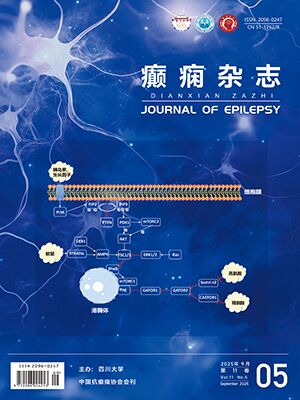| 1. |
Kakita A. Surgical pathologic features of cerebral cortical lesions taken from 600 patients with intractable epilepsy. Brain Dev, 2013, 35(8): 793-801.
|
| 2. |
Jayalakshmi S, Nanda SK, Vooturi S, et al. Focal cortical dysplasia and refractory epilepsy: Role of multimodality imaging and outcome of surgery. AJNR J Neuroradiol, 2019, 40(5): 892-898.
|
| 3. |
Blümcke I, Thom M, Aronica E, et al. The clinicopathologic spectrum of focal cortical dysplasias: A consensus classification proposed by an ad hoc Task Force of the ILAE Diagnostic Methods Commission. Epilepsia, 2011, 52(1): 158-174.
|
| 4. |
Ahmed R, Rubinger L, Go C, et al. Utility of additional dedicated high-resolution 3T MRI in children with medically refractory focal epilepsy. Epilepsy Res, 2018, 143(2018): 113-119.
|
| 5. |
Veersema TJ, Ferrier CH, van Eijsden P, et al. Seven tesla MRI improves detection of focal cortical dysplasia in patients with refractory focal epilepsy. Epilepsia Open, 2017, 2(2): 162-171.
|
| 6. |
Ma D, Jones SE, Deshmane A, et al. Development of high-resolution 3D MR fingerprinting for detection and characterization of epileptic lesions. J Magn Reson Imaging, 2019, 49(5): 1333-1346.
|
| 7. |
Widjaja E, Otsubo H, Raybaud C, et al. Characteristics of MEG and MRI between Taylor's focal cortical dysplasia (type II) and other cortical dysplasia: surgical outcome after complete resection of MEG spike source and MR lesion in pediatric cortical dysplasi. Epilepsy Res, 2008, 82(2-3): 147-155.
|
| 8. |
Jin B, Krishnan B, Adler S, et al. Automated detection of focal cortical dysplasia type II with surface-basedmagnetic resonance imaging postprocessing and machine learning. Epilepsia, 2018, 59(5): 982-992.
|
| 9. |
Chen J, Chen X, Huang C, et al. Predictors of seizure recurrence in patients with surgery for focal cortical dysplasia: pairwise and network meta-analysis and trial sequential analysis. Childs Nerv Syst, 2019, 35(5): 753-767.
|
| 10. |
Guye M, Bartolomei F, Ranjeva JP. Malformations of cortical development: The role of 7-Tesla magnetic resonance imaging in diagnosis. Rev Neurol(Paris), 2019, 175(3): 157-162.
|
| 11. |
Hong SJ, Bernhardt BC, Caldairou B, et al. Multimodal MRI profiling of focal cortical dysplasia type II. Neurology, 2017, 88(8): 734-742.
|
| 12. |
Taylor DC, Falconer MA, Bruton CJ, et al. Focal dysplasia of the cerebral cortex in epilepsy. J Neurol Neurosurg Psychiatry, 1971, 34(4): 369-387.
|
| 13. |
Jin B, Wang J, Zhou J, et a1. A longitudinal study of surgical outcome of pharmacoresistat epilepsy caused by focal cortical dysplasia. J Neurol, 2016, 263(12): 2403-2410.
|
| 14. |
Chern JJ, Patel AJ, Jea A, et a1. Surgical outcome for focal cortical dysplasia: an analysis of recent surgical series. A review. J Neurosurg Pediatr, 2010, 6(5): 452-458.
|
| 15. |
Tassi L, Garbelli R, Colombo N, et al. Electroclinical, MRI and surgical outcomes in 100 epileptic patients with type II FCD. Epileptic Disord, 2012, 14(3): 257-266.
|
| 16. |
Bourdillon P, Rheims S, Catenoix H, et al. Malformations of cortical development: New surgical advances. Rev Neurol (Paris), 2019, 175(3): 183-188.
|
| 17. |
Kwon HE, Eom S, Kang HC, et a1. Surgical treatment of pediatric focal cortical dysplasia: Clinical spectrum and surgical outcome. Neurology, 2016, 87(9): 945-951.
|
| 18. |
Colombo N, Tassi L, Deleo F, et al. Focal cortical dysplasia type Ⅱa and Ⅱb: MRI aspects in 118 cases proven by histopathology. Neuroradiology, 2012, 54(10): 1065-1077.
|
| 19. |
Chassoux F, Landré E, Mellerio C, et al. Type II focal cortical dysplasia: electroclinical phenotype and surgical outcomerelated to imaging. Epilepsia, 2012, 53(2): 349-358.
|




